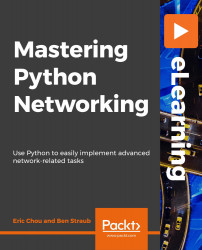Chapter 6
Network Security with Python

Section 2
The Lab Setup
The devices being used in this chapter are a bit different from the previous chapters. In the previous chapters, we were isolating a particular device by focusing on the topic at hand. For this chapter, we will use a few more devices in our lab in order to illustrate the function of the tools that we will be using. The connectivity and operating system information are important as they have ramifications regarding the security tools that we will show later in this chapter. For example, if we want to apply an access list to protect the server, we need to know what the topology looks like and which direction the client is making their connections from. The Ubuntu host connections are a bit different than what we have seen so far, so please make reference back to this lab section when you see the example later if needed.



